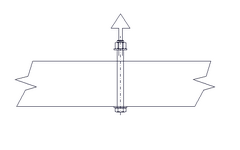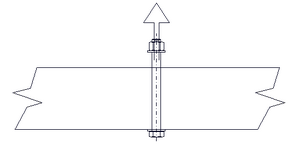Let's say a 3/4" hole is formed in precast concrete slab so that a 1/2" or 5/8" bolt can later be inserted through the hole to be an anchor. Would this anchor be considered cast-in or post-installed for the purpose of determining factors per ACI 318-19 Ch. 17?
An argument for considering the anchor to be cast is that since the hole is pre-formed, there is no stress induced in the concrete by drilling of the hole, which seems to be a consideration in R17.6.2.6.1.
An argument for considering the anchor to be post-installed is that the anchor does not benefit from cement bond, although for a short anchor with minimal development length, this seems unlikely to be significant.
An argument for considering the anchor to be cast is that since the hole is pre-formed, there is no stress induced in the concrete by drilling of the hole, which seems to be a consideration in R17.6.2.6.1.
An argument for considering the anchor to be post-installed is that the anchor does not benefit from cement bond, although for a short anchor with minimal development length, this seems unlikely to be significant.


